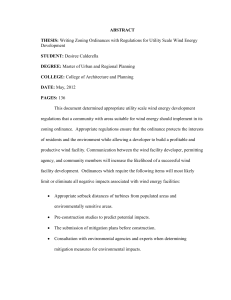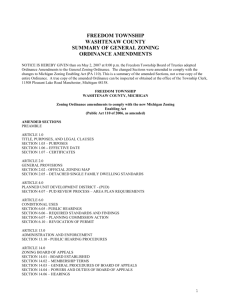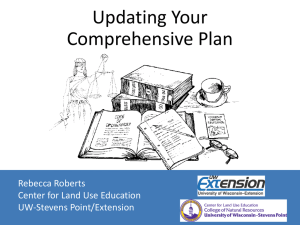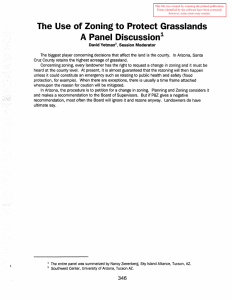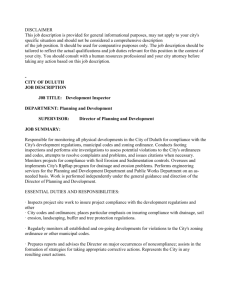Updating Your Comprehensive Plan Rebecca Roberts Center for Land Use Education
advertisement
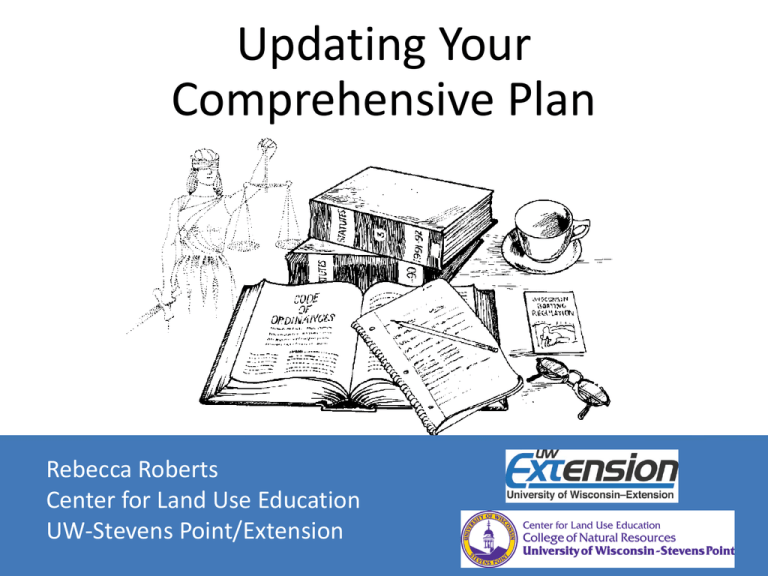
Updating Your Comprehensive Plan Rebecca Roberts Center for Land Use Education UW-Stevens Point/Extension Tonight’s Program • • • • • • Purpose and benefits of planning Comprehensive planning requirements Sample planning process Public participation Plan implementation and monitoring Making decisions consistent with the plan What is planning all about? • Examines past, present and future trends • Lays out a long-term vision and provides concrete goals and recommendations for the community to aspire to What is planning all about? • Provides a proactive approach to the future • Fosters predictable and defensible decisions • Allows a community to identify, anticipate, balance and decide how to meet its needs: – – – – – Protection of community resources and character Targeted economic development and public investments Cost-effective delivery of services Intergovernmental communication and cooperation Balance of community interests and private rights A Guide for Decision-Making Consult your plan when considering: • Zoning, subdivision, and other land use approvals • Decisions about expansion of major infrastructure • Decisions about location of new infrastructure • Decisions about annexation of additional territory • Decisions about major public investments Consequences of Not Planning The law provides no state agency oversight or review of local plans, but you open yourself to: • Inconsistent decisions • Greater exposure to law suits • Poor land use and environmental management • Inefficient development Comprehensive Planning Law • Beginning January 1, 2010, changes to zoning, land division and official mapping ordinances must be consistent with an adopted comp plan – Plans must address 9 elements – Written procedures for public participation – Distribution of plans for review – Adopt plan by ordinance – Update at least once every 10 years Comprehensive Plan Status 67% of local governments have zoning, land division or official mapping functions which require consistency with a comprehensive plan. 84% have adopted a plan or started planning. Content - 9 Required Elements • • • • • • • • • Issues & Opportunities Housing Transportation Utilities & Community Facilities Agricultural, Natural & Cultural Resources Economic Development Intergovernmental Cooperation Land Use Implementation Legal Process 1. Written public participation procedures adopted by governing body – – – Methods for fostering public participation Methods for distributing proposed, alternative or amended elements of comprehensive plan Opportunity for written comments and response by local government (Wis Stat. 66.1001(4)) Legal Process 2. Publish class 1 notice at least 30 days prior to public hearing on proposed plan/amendment 1. Date, time and place of hearing 2. Summary, which may include map, of proposed plan or amendment 3. Local government contact 4. Info to inspect or obtain plan prior to hearing (Send notice to nonmetallic mineral mining interests and those who have submitted a written request) (Wis Stat. 66.1001(4)) Legal Process 3. Local government approval – Plan Commission adopts resolution recommending adoption of plan (majority vote required) – Governing Body adopts comprehensive plan by ordinance (majority vote required) (Wis Stat. 66.1001(4)) Legal Process 4. One copy of an adopted comprehensive plan or amendment must be sent to: – – – – Wisconsin Department of Administration Regional Planning Commission County and adjacent units of government Public library (Wis Stat. 66.1001(4)) Plan Updates and Amendments • Why Update Your Plan? – – – – – Unforeseen or changing conditions Changing community desires Changes in political leadership Plan not performing as expected Errors in the original plan “The real issue is not the age of the plan, but its effectiveness.” Plan Updates and Amendments • Set timeline and process for reviewing plan amendments: – Amendments considered upon request of landowner, developer, governing body, staff – Minor changes considered annually – Major review and rewrite at least once every 10 years as required by state statutes • Strike balance between rigidity and flexibility in plan amendment process Plan Updates and Amendments • Identify criteria for reviewing plan amendments Continued… (City of LaCrosse Comprehensive Plan) Plan Updates and Amendments • Audit Plan for Performance: – Review goals, objectives and policies to see if they are being implemented. Reprioritize and assign responsible party. – Review timid, non-committal or ambiguous language such as “consider”, “may” and “explore”. These terms might have been politically acceptable but do not provide much guidance. – Consider updates to the future land use map and accompanying text to better inform the desired timing and pattern of future growth. Plan Updates and Amendments Option 1: Create Plan Supplement – – – Existing plan is retained in its current form. Supplement document highlights new information and policies. Easiest, least costly approach. May be difficult to ascertain which policies are current. Option 2: Selectively Revise Portions of Plan – – – More cost-effective and less time consuming than total rewrite. Works best if current plan is well-written/organized. May make it difficult to take a fresh look at issues or problems. Plan Updates and Amendments Option 3: Update Inventory or Policy Section – – – Distinct inventory and policy sections which can be updated independently. Provides opportunity to focus on policies. Some time and cost savings over complete rewrite. Option 4: Create Entirely New Plan – – – Major undertaking – new plan written from scratch. Avoids time-consuming and potentially tedious task of working with existing plan language or format. Works best if existing plan requires major overhaul. Recommended Resources Sample Documents for Comprehensive Plan Amendments Southeastern Wisconsin Regional Planning Commission, June 2010 www.sewrpc.org/SEWRPC/communityassistance/ EducationalServices2.htm#SmartGrowth Includes: – – – – – – Application form Public hearing notice Plan commission resolution recommending plan amendment Local government ordinance adopting plan amendment Sample public participation procedures Local government resolution adopting procedures Planning Process Establish need and scope of plan Implement and monitor plan Identify issues and formulate vision Public Participation Review and adopt plan Collect and analyze data Set goals, objectives, policies Sample Planning Process Pre-Planning I. Data and Analysis II. Issue Identification III. Goals & Objectives IV. Strategy Formulation Incorporate 9 elements 1. Issues and Opportunities 2. Intergovernmental Cooperation 3. Utilities and Community Facilities 4. Agricultural/Natural/Cultural Resources 5. Housing 6. Transportation 7. Economic Development 8. Land Use 9. Implementation Public Participation V. Review and Approval Implementation and Monitoring Planning Elements • Consider time and relationship of elements • Focus on topics that are most important to your community • Consider reorganizing, simplifying or adding topics/chapters: Energy Food systems Public health Sustainability Sample Planning Process Pre-Planning I. Data and Analysis II. Issue Identification III. Goals & Objectives IV. Strategy Formulation V. Review and Approval Implementation and Monitoring • Pre-Planning – Establish plan commission and committees – Assemble planning team – Design planning process – Prepare public participation plan – Begin public information and education A plan for planning – What is the purpose of the planning effort? – What geographic area will you cover? Will this be a multi-jurisdictional effort? – Who is going to use the plan, and how? How does this translate to form, content, and appearance of plan? – Who is going to prepare the plan? (prepare an RFP if hiring a consultant or a short-term planner) – How will you fund the process? – What process will you follow when preparing the plan? – What education and relationships do you need to build before getting started? Sample Planning Process Pre-Planning I. Data and Analysis II. Issue Identification III. Goals & Objectives IV. Strategy Formulation V. Review and Approval • Step I: Data Collection and Analysis – Gather local data – Prepare trends, projections, graphs, charts, maps, etc. Implementation and Monitoring Data Collection and Analysis • Example: Agricultural, Natural and Cultural Resources Element Charts, Maps, Graphics • Business Locations • Potential Development Sites Conserve, Enhance, Transform Sample Planning Process Pre-Planning I. Data and Analysis II. Issue Identification III. Goals & Objectives IV. Strategy Formulation V. Review and Approval Implementation and Monitoring • Step II: Issue Identification – Identify and prioritize key community issues, challenges, opportunities and desires – Create community vision Community Survey • Example: Columbia County – 2003 county-wide survey: • 90% feel it is important to permanently retain productive agricultural lands in the county • 88% find the county a favorable place to live • 74% would like to live in the county permanently • 73% would like to see additional retail or commercial businesses SWOT Analysis Future Vision Visioning is a process by which a community envisions the future it wants, and plans how to achieve it. Steps in Planning Process Pre-Planning I. Data and Analysis II. Issue Identification III. Goals & Objectives IV. Strategy Formulation V. Review and Approval Implementation and Monitoring • Steps III-IV: Goals, Objectives & Strategies – Develop goals and objectives with input of community members – Identify possible policies, programs, actions or other implementation tools to accomplish goals and objectives – Include measurable indicators Goals, Objectives & Strategies • Example: Agriculture, Town of Dunn Goal: Protect the Town’s agricultural areas Objective: Protect farm operations from incompatible adjacent land uses or activities that will adversely affect the long-term agricultural investment in land and improvements. Action: Minimize the amount of farmland rezoned to nonagricultural use. Areas to be considered for rezoning should be: a. b. c. d. Land that is inaccessible to farm machinery. Land that would not place the house in the middle of a field. Non-prime agricultural land. Land where development would destroy important natural features. Analysis of Alternatives Alternative 1 – Status Quo City of Marshfield Analysis of Alternatives Alternative 2 – Traditional Neighborhoods City of Marshfield Analysis of Alternatives Alternative 3 – Mixed Use Neighborhoods City of Marshfield Sample Planning Process Pre-Planning I. Data and Analysis II. Issue Identification III. Goals & Objectives IV. Strategy Formulation V. Review and Approval • Step V: Plan Review and Approval – Draft plan presented for review – Plan commission recommends adoption of plan by resolution – Governing body adopts plan by ordinance following public hearing Implementation and Monitoring Legal Process • Same procedure for plan adoption and updates (Wis Stat. 66.1001(4)) – – – – – Written public participation procedures Plan distributed for review and comment Class 1 notice provided at least 30 days prior to public hearing PC resolution recommending plan adoption GB ordinance adopting plan Sample Planning Process Pre-Planning I. Data and Analysis II. Issue Identification III. Goals & Objectives IV. Strategy Formulation V. Review and Approval Implementation and Monitoring • Plan Implementation, Monitoring & Updates – Create and adopt implementation tools – Review annually for performance – Update plan at least once every 10 years • Develop criteria for considering amendments and determining consistency • Consider incremental updates once a year • Use same process to adopt plan Plan Implementation “The comprehensive plan is a central organizing umbrella under which other plans, regulations – Duerksen, 2009 and initiatives exist.” -- 2009 Wisconsin Act 372 clarified that the comprehensive plan is not a regulation -- Refer to the implementation element for a list of programs, policies, tools, actions and other recommendations to implement the plan Plan Implementation Toolbox Regulatory Tools: Educational/Voluntary/Fiscal Tools: Zoning Official mapping Subdivision regulation Cluster/conservation design Sign ordinances Driveway ordinances Building and sanitary codes Livestock facility siting ordinance • Stormwater management • Pamphlets, brochures and other educational materials • Public land acquisition • Land conservation programs • Purchase or transfer of development rights • Capital improvement plan • Impact fees and user fees • Density bonus • • • • • • • • • And many, many more… Plan Implementation • Identify for each tool: – Timeline for implementation – Resources required – Party responsible for implementation – Indicators or measures of success Example • Bicycle Master Plan – Performance Measures Monitoring Progress Annual Self-Audit • Hold joint meeting with governing body, plan commission, zoning board and staff • Monitor progress towards plan implementation • Summarize number and types of rezones, conditional uses, variances, appeals, etc. • Make recommendations to clarify plan or ordinance language that is unclear, inadequate, overly restrictive or otherwise problematic See PC Handbook (chapter 6, pg. 11) or BOA Handbook (chapter 19) Plan Implementation Remember, a plan is really only useful when implemented, but a plan will only be implemented if it’s useful. Sample Planning Process Pre-Planning I. Data and Analysis II. Issue Identification III. Goals & Objectives IV. Strategy Formulation V. Review and Approval Implementation and Monitoring Public Participation • Public Participation: – – – – Prepare a written public participation plan Distribute copies of the plan for review Solicit and respond to written comments Hold a public hearing prior to plan adoption Public Participation • Identify your audience/stakeholders: – those who believed their interests are affected – those whose power or influence is enhanced or diminished by a decision – those with an axe to grind – political or social movers and shakers – representatives of decision-making bodies – economic, social, political and cultural interests Public Participation • Levels of public involvement: – Awareness – website, television, newspaper, postcard – Education – fact sheet, display, speakers forum – Input – survey, focus group, public hearing – Participation – visioning workshop, advisory committee Political Process Bring constituents into the drafting process: Developers, Neighborhood groups, Environmental groups, Design professionals, Business owners, Other community groups Identify “project champions” – officials/citizens who will move project forward and keep it on the agenda Political Process Talk to elected officials on a regular basis long before you have something for them to adopt: Why are we doing this? What are the current regulations? What are the proposed changes? How will the proposed changes impact constituents? What to avoid… Drafting Team • • • • • • • Staff Consultant Governing body Plan commission Advisory committee Special interests/knowledge Legal counsel Drafting Tips Humanizing the Monster Plan • • • • • Long plans are scary Short plans are incomplete Brevity is good Completeness is good Leaving things out is bad Document Design • Organization and structure (table of contents, numbering, index, appendix) • • • • • Writing style (avoid legalese where possible) Cross-referencing (say it once) Tables (summarize large sums of data) Graphics (show what you mean) White space and contrast Graphics • Illustrate your plan, ordinances and related materials with pictures, diagrams and nontechnical language • Prepare a glossy, informational brochure or poster plan summarizing the plan’s main points City of Bayfield “Poster Plan” Signs of a Good Plan • • • • • Legally sound Reflects community desires Result of public involvement Users understand it Local officials can apply it Consistency Consistency Review • Beginning Jan. 1, 2010, new or amended zoning, land division and official mapping ordinances must be consistent with the plan • Consistent means “furthers or does not contradict the objectives, goals and policies contained in the comprehensive plan” (2009 Wisconsin Act 372) Consistency • • • • Not a literal, exact translation from plan to ordinance Ordinance usually includes more detailed maps/text Absence of policy does not create an inconsistency Plan and supporting ordinances not contradictory Example: Town of Wilson, Lincoln County Consistency Example • Village of Black Creek – Future Land Use Maps 10 and 20 year future land use maps show location, intensity and timing of development 2015 2025 Consistency Example • Village of Mount Horeb – Future Land Use Map Plan specifies conditions under which growth may occur: “development of this area is conditioned on improvement of a new north-south collector road” Consistency Example • Village of DeForest – Growth Phasing Map Comprehensive plan specifies desired timing of development Consistency Example • Village of DeForest – “Consistency Matrix” Future land use categories include zoning district recommendations Consistency Example • City of Sparta – Development Concepts Map Maps are drawn in “bubble” fashion showing general locations for future development Consistency: Whose plan controls? • Whose plan controls? • Nothing says the county’s plan controls over town plans! • Key point: The 1999 Comprehensive Planning Law did not give or take away authority from any local unit of government • Local governments need to plan for things they have jurisdiction over Example: Zoning • Towns that are unzoned do not need to plan for zoning • Towns that have their own zoning, need to plan for that zoning • Towns under county zoning, need to work with the county – The county does not have unilateral authority – Towns choose to adopt county zoning and have veto authority over amendments Example: Roads • Towns plan for town roads. Counties can’t set standards for town roads. • Counties plan for county highways. Towns can’t set standards for county roads. Intergovernmental Cooperation • Address intergovernmental relationships: – Annexation and boundary wars – County-town cooperation in zoning administration, comprehensive planning, etc. – Revenue and cost sharing options – Open lines of communication Intergovernmental Cooperation • Suggestions for future land use mapping: – Develop county-wide land use classification system – Allow for some customization of classifications at town level (i.e. provide density ranges) – Review inconsistencies between govt. boundaries – Counties are required to incorporate city/village maps without change – Decide how you will incorporate town maps Intergovernmental Cooperation • 3 Types of Legal Agreements: – Stipulations and orders – settle annexation lawsuits – General agreements – contract for joint municipal services – Cooperative boundary agreement – agree on boundary, land use and service issues Intergovernmental Cooperation Thank You! Rebecca Roberts Center for Land Use Education www.uwsp.edu/cnr-ap/clue rroberts@uwsp.edu 715-346-4322
